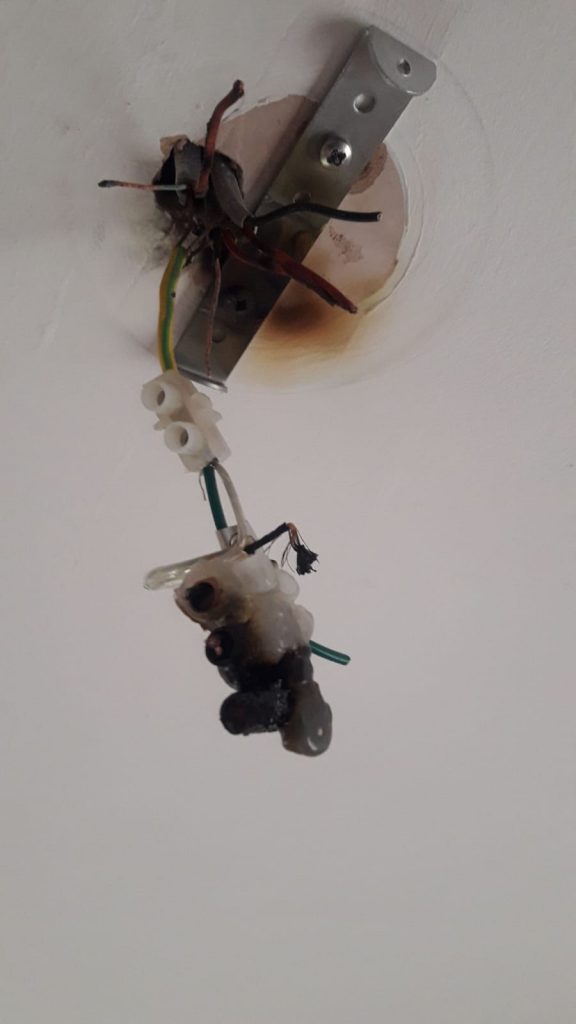Thermal Damage to Cable Insulation
Did you have an EICR (otherwise known as a landlord/homebuyer report) completed and you received a code indicating that you have “Thermal Damage to Cable Insulation”?
You may have been left wondering what exactly this means and how best to approach repairing the thermal damage to the cable insulation.
If your electrician has failed to explain, or ideally attach photos to the electrical report, then our blog post should help clear things up.

What Causes Thermal Damage to Cable Insulation?
Whilst the title of the issue may give some clue as to the cause of the problem, this is merely a symptom of something which is actually more sinister.
Yes, thermal damage to cable insulation is caused by heat in the cable. The issue is that electrical cables should not be getting to a temperature that can cause this.
The cause of cables getting to such temperatures can normally be traced back to one of three issues:
- Loose Connections – when any electrical connections begin to work loose (or were never installed tightly in the first place), this loose connection causes localised heat to build up. As the copper conductor of the cable heats up, this heat at the end causes the cable insulation to discolour, bubble and eventually melt. This issue can also present itself as melted parts within switches and sockets as the heat causes them to distort and fail.
- The cable has been incorrectly sized for the load which it carries – When choosing cables, electricians do a series of calculations to determine which size of cable needs to be installed for each circuit. Various factors affect these calculations including the type of cable itself, how it is installed and if run adjacent to other cables. If the calculation has been performed incorrectly, or else not at all, and a load too high for the cable installed is used, this can cause the cable to heat up dramatically. It might not be that the cable was wrong to start with, but we have seen plenty of occasions where higher loads (ie: new shower or more powerful cooker) have been placed on a circuit and the circuit breaker swapped for a larger one without any thought.
- Other heat sources damaging cable – sometimes the issue can be caused by other sources of heat, warming the cable insulation up to a point where it is damaged. This issue tends to be isolated to things which create a lot of their own heat, such as an oven or the bulb within a light fitting. If cables are laid over recessed downlights they can also be susceptible to damage from heat. It could be that the cable has not been installed carefully to avoid the hot item, or it could be from something such as using a bulb too powerful for the fitting.

How Serious Of An Issue Is This?
Any thermal damage, melting or scorching within an electrical installation is very serious and should be rectified as a matter of urgency.
Whilst this particular problem can be caused by a range of issues, the damage to the cable itself would attract, as a minimum, a C2 – POTENTIALLY DANGEROUS code on an electrical inspection.
This could even give rise to a C1 – DANGER PRESENT code if the thermal damage is severe enough to expose live parts.
Any thermal damage to cables should, in our opinion, be isolated and repaired immediately.
How to fix the issue of Thermal Damage to Cable Insulation?
Once the cable insulation has been damaged in this way, replacement of the damaged section is the only acceptable way to repair this fault.
Due to the number of different causes for this problem, it is important to identify which is responsible and repair that issue BEFORE simply replacing any cable.
Loose connections may need tightening & quite possibly the accessory/switchgear replacing if it has become damaged also.
Undersized cables will need the correct calculation completing and either the load reducing or the cable uprating to suit. According to Your Electrician Gold Coast, undersized cables and poorly calculated circuits are the number one cause of thermal damage.
In areas where external heat has damaged the cable insulation, it may be that the cable needs rerouting away from sources of heat or that specific cable for use in areas exposed to higher temperatures is used.
If the issue is only confined to the connection end of the cable, simply removing a section (assuming there is enough spare) and reterminating may suffice. Be aware that the damage can often go much further than appears on the outside of the insulation, effectively “melting” the inside of the PVC insulation to the copper cable.
Unfortunately quite often replacement of larger sections of cable may be necessary. This being either due to the damage itself or as the cable with the damage removed is now too short.
Fixing High Temperatures That Cause Thermal Damage to Cable Insulation
Again, it is important to verify the initial cause of the high temperatures so that similar thermal damage of the new cable can be avoided. Simply replacing the cable without identifying and rectifying the root cause is highly likely to end up in a repeat of the same problems.
Your inspecting electrician will be able to give further advice on what the underlying cause of the thermal damage to the cable is in your particular situation.
If you need any further advice with regards thermal damage to cables please feel free to get in touch via email.
Regards,
James – ElectricBlu Contractors